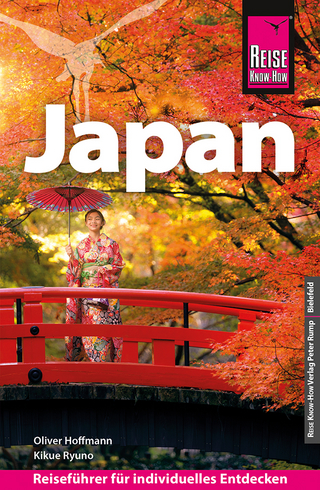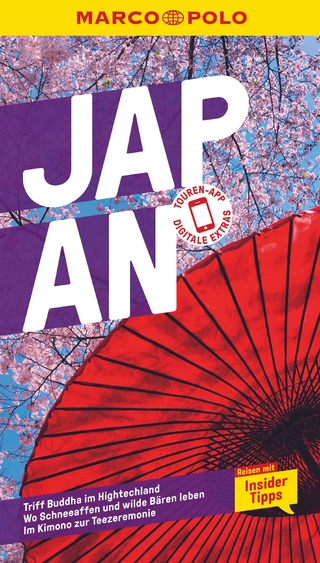
Japan from Anime to Zen
Stone Bridge Press (Verlag)
978-1-61172-063-1 (ISBN)
- Titel z.Zt. nicht lieferbar
- Versandkostenfrei innerhalb Deutschlands
- Auch auf Rechnung
- Verfügbarkeit in der Filiale vor Ort prüfen
- Artikel merken
This friendly guide offers concise but detailed demystifications of more than 85 aspects of ancient and modern Japan.
It can be read in sequence, or just dipped into, depending on the moment’s need. Explanations go much deeper than a typical travel guide and cover 1,500 years of history and culture, everything from geisha to gangsters, haiku to karaoke, the sun goddess to the shogunate . . . and anime to Zen.
David Watts Barton is an award-winning freelance journalist who has covered popular music, culture, travel and outdoor recreation for 40 years for newspapers, magazines, radio and online. His former employers include The Sacramento Bee, Bloomberg, and NPR. For the last five years he has worked exclusively in Japan. He was writer/editor of Japanology.org and has written freelance for Japanese clients that include architectural firms, art galleries, hotels and branding companies. In addition to awards including the first Arts Journalist of the Year, given by the Sacramento Arts and Business Council in 2011, Barton has been a fellow at UC Berkeley's Knight Digital Media Center and at the University of Southern California’s Annenberg School for Communication and Journalism.
TABLE OF CONTENTS (tentative)
Introduction: A Land Apart: Japan’s Defining Geography
Part One: Food and Drink
Introduction to Part One
Chapter 1: The Greenest Staple: Sea Kelp and its Many Uses
Chapter 2: Umami, Japan’s “Fifth Flavor”
Chapter 3: Condiments and Ingredients in Japanese Cuisine
Chapter 4: Some Exotic Foods the Japanese Love
Chapter 5: Rice and its infinite products
Chapter 6: Noodles: Udon, Ramen, Soba, Yakisoba and Somen
Chapter 7: Japan’s consensus “Greatest Invention”: Instant Ramen
Chapter 8: What Makes Kobe Beef the World’s Best
Chapter 9: Japanese Table Manners
Chapter 10: The Fine Art of Kaiseki Dining
Chapter 11: Beyond The Pub: Japan's Izakaya Culture
Chapter 12: All About Sake
Chapter 13: The Unique Qualities of Japanese Whiskey
Chapter 14: Beginners Guide to Japanese Tea
Chapter 15: Wagashi, Japan’s Irresistible Sweets
Part Two: Modern Arts, Entertainment and Sports
Introduction to Part Two
Chapter 16: Karaoke!
Chapter 17: Kawaii and the Culture of Cute
Chapter 18: The Story of Manga
Chapter 19: The Art of Anime
Chapter 20: The Films of Hayao Miyazaki
Chapter 21: 8 Japanese Films to See Before You Visit Japan
Chapter 22: Internationally-known Modern Japanese Artists
Chapter 23: How Art Transformed Naoshima Island
Chapter 24: Crucial Post-War Japanese Architects
Chapter 25: A Compact History of the Capsule Hotel
Chapter 26: Bujitsu: Six Contemporary Martial Arts
Chapter 27: How Baseball Came to Japan (and Became Japanese)
Chapter 28: Sumo Wrestlers: The Life of a True Warrior
Chapter 29: The Novel: Japan’s 20th Century Literary Titans
Part Three: Traditional Arts and Culture
Introduction to Part Three
Chapter 30: Hanami, Japan’s the Most Iconic Scenery
Chapter 31: Elements of Japanese Garden Design
Chapter 32: The Art of Ikebana
Chapter 33: The Art of Bonsai: Creating Little Green Worlds
Chapter 34: From Food to Flooring: The Many Uses of Bamboo
Chapter 35: Kyoto and the Template of Japanese Architecture
Chapter 36: Japan’s Delightful Ryokan
Chapter 37: The Pleasures of the Traditional Onsen
Chapter 38: The Sento, Japan’s Everyday Onsen
Chapter 39: Haiku and the Japanese Love of Brevity
Chapter 40: The Strange Story of Japan's Alphabet(s)
Chapter 41: Japanese Woodblock Printing
Chapter 42: Folded Form: Origami and Kirigami
Chapter 43: Three Forms of Classic Japanese Theater
Chapter 44: The Kimono, Japan’s Traditional Garment
Chapter 45: Elements of a Traditional Japanese Wedding
Chapter 46: The Japanese Tea Ceremony
Part Four: History and Archetypes
Introduction to Part Four
Chapter 47: Amaterasu and the Gods of Ancient Japan
Chapter 48: Carp, Cranes and other Symbolic (but Real) Animals
Chapter 49: Gifts, Giri and Japan’s Obsession with Packaging
Chapter 50: The Heian Period: Japan’s Classical Era
Chapter 51: The Shogunate
Chapter 52: Commodore Perry and the Opening of Japan
Chapter 53: Ways the Meiji Restoration Shaped Modern Japan
Chapter 54: The Samurai Class: More Than Warriors
Chapter 55: The Mysterious Ninja
Chapter 56: The Role of Buddhist Monks in Modern Japan
Chapter 57: Things to Remember When Visiting a Shrine or Temple
Chapter 58: Who the Geisha Really Were – and Are
Chapter 59: The Great Japanese Empire
Chapter 60: The Imperial Family Today
Chapter 61: Japan’s Demographic Time Bomb
Part Five: The Foundations of Japanese Culture
Introduction to Part Five
Chapter 62: The Ubiquitous Power of Kata
Chapter 63: Bowing, the Fundamental Courtesy
Chapter 64: The Individual and the Group
Chapter 65: Japan’s “High Context” Society
Chapter 66: Honne vs. Tatemae: The Two Faces of Japan
Chapter 67: Uchi-Soto: In-Groups and Out-Groups
Chapter 68: What is Ki?
Chapter 69: The Two Pillars: Buddhism and Shinto
Chapter 70: Zen Buddhism v. Pure Land Buddhism
Chapter 71: The Subtle, Confounding Zen Koan
Chapter 72: The Five Elements in Japanese Culture
Chapter 73: What Does Wabi-Sabi Mean?
Chapter 74: Ikigai: A Reason for Living
| Erscheinungsdatum | 14.05.2021 |
|---|---|
| Zusatzinfo | 30 black and white line drawings |
| Verlagsort | Berkeley CA |
| Sprache | englisch |
| Maße | 133 x 203 mm |
| Themenwelt | Kunst / Musik / Theater ► Kunstgeschichte / Kunststile |
| Reiseführer ► Asien ► Japan | |
| Geisteswissenschaften ► Geschichte ► Regional- / Ländergeschichte | |
| Sozialwissenschaften | |
| ISBN-10 | 1-61172-063-X / 161172063X |
| ISBN-13 | 978-1-61172-063-1 / 9781611720631 |
| Zustand | Neuware |
| Haben Sie eine Frage zum Produkt? |


